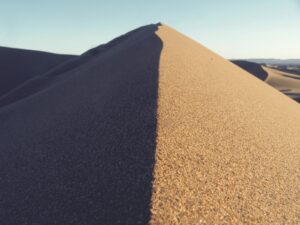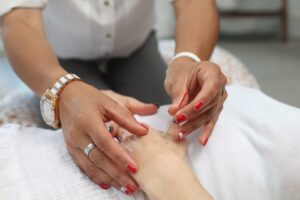Subscribe to the Newsletter
If you are interested in understanding how Traditional Chinese Medicine can improve your life sign up to my newsletter for the latest updates.

The Dr Richard Tan Balance Method comes from a Chinese family tradition different to the Chinese medicine taught in the ‘normal’ way.
We use it for many problems.
Because it focuses on where the pain or discomfort is and the acupuncture channels that run through it, it does not rely so much on a knowledge of syndromes.

But acupuncturists need to really know their acupuncture channel theory to practise this form of acupuncture. Even so, it is often just as quick to practise as the more normal systems of acupuncture (once you’ve got the theory in your head, that is!)
And it has the great advantage that the patient gives immediate feedback as to how well the treatment is working.
Usually, I ask the patient to assess the level of pain or discomfort, before treatment, as being 10/10.
During treatment I hope to reduce this to under 2/10, if possible 0/10. I would say that often I achieve this within a few minutes.
I then leave the patient to rest for a while, with the needles still inserted. Often the patient goes to sleep or sinks into a pleasant reverie. Music can help them reach the right ‘space’.
The principal acupuncture channels and their subsidiary channels form a lattice throughout the body. Many channels interconnect with other channels, not just at different points along the channels, but because they share certain characteristics with other channels.
Now it gets a bit technical – don’t start here if you are new to acupuncture! Click here for a simpler introduction.
Dr Jonathan Shubs developed his Unified Acupuncture Theory mainly from the Tan Balance Method and Dr Tung’s acupuncture system. Each channel has up to six other channels where points can reduce or clear problems along it.
To clear pain or discomfort along, say, the Foot Shao Yin channel you would use points along one or more of the following channels. Each has a special relationship with the Foot Shao Yin channel:
Why do we use these six channels and not the other six? Well, there’s a theory but it really doesn’t make sense if you are new to acupuncture.
(Indeed, many acupuncturists who are certainly not new to the subject find it hard to understand!)
For example, why don’t we call the ‘Foot Shao Yin’ channel the ‘Kidney channel’, which is the same thing?
Answer: because that wouldn’t bring to mind the reason for choosing the other channels. Otherwise, you’d just have to learn them by rote.
Rote learning is not difficult for just one channel, but there are twelve of them! Interconnections would have to be learned for all of them and without the underlying theory for support, it would be easy to make mistakes.
Using the original Chinese channel names makes it easier.
However, it is rather technical and few acupuncturists learn about it when going through their initial training.
With the Tan Balance method, you search for points on the associated channels. These evoke discomfort on pressure. These points are then needled. (… a rather brief summary!)
In the Unified acupuncture theory method, finding the points in question is more discerning. You look for points that provide relief at the painful site. The degree of improvement helps decide which points to use.
The points used may or may not be points recognised by classical acupuncture theory. In fact, they often aren’t but, if they can immediately reduce the discomfort from 10/10 down to 0/10, they are treated with great attention to detail and careful needle manipulation.
In many cases, you choose points on the side of the body opposite to the site of the pain. (Yes, there is a theory for that too.)
Of course, quite often you do choose traditional or classical points, because they work! But if using the Tan Balance method, or even more so the Unified Acupuncture theory, a point is not chosen because it is well-known, but because it works in this case.
No system is flawless. One of the problems with the Tan Balance method is that needles should remain in situ for at least 45 minutes, and preferably 90 minutes. This is often longer than the time available for treatment.
Also, during treatment, you may need to manipulate the needles several times during the 90 minute session.
Additionally, often a series of daily or two-daily treatments works best at clearing the ingrained ‘pain’ or ‘problem’. Not all patients can afford to come daily for a week.
Even so, using the ‘enhanced’ Unified Acupuncture theory system, (which explains and embraces Dr Tung’s system as well) and incorporating other systems including Japanese, Korean, 5 Element and traditional Chinese theory, for example, I have achieved really astounding results with the Tan Balance method often in just one or two treatments. (Well, I was astounded, even if the patient expected it so thought less of it!)
So, good and lasting effects can occur if the needles are removed after 15-30 minutes. 45-90 mins may be the ideal, but this isn’t always possible and treatment can be effective in a shorter period.
The underlying theory emerges from study of the I Ching, the ancient Book of Change. This is, if you like, the basic theory of yin and yang.

It employs hexagrams of single or broken horizontal lines to represent Yang (unbroken lines – see above) and Yin (broken lines – not shown).
There are 64 hexagrams and if you’re feeling brave and somewhat mathematically inclined, the Yin-Yang code, by Dr Ning Lu may help you get to grips with it.
Warning! This is not an easy read, and the early chapters take liberties with the English language.
However, getting from the Book of Change, the I Ching, to knowing which acupuncture channels to use does take a bit of explaining. I suggest you go on a course to learn about it.
To try to explain it here would require a very long page, too long to be digestible for most people.

Stay in Touch!
No spam, only notifications about new articles and updates.

Book a Video consultation if you want to know more about your symptoms

This Introductory Chinese medicine course introduces you to the amazing thinking behind this ancient medicine, now increasingly in demand.

The Scottish College for Chinese medicine provides introductory courses for all, explaining Chinese medicine and its cultural background.

Master Tung’s acupuncture is a hidden treasure, lost to China but recovered in Taiwan from where it spread round the world.

Knee pain has five main causes. It’s certainly worth trying acupuncture before you resort to surgery!
Subscribe to the Newsletter
If you are interested in understanding how Traditional Chinese Medicine can improve your life sign up to my newsletter for the latest updates.
Subscribe to the Newsletter
If you are interested in understanding how Traditional Chinese Medicine can improve your life sign up to my newsletter for the latest updates.